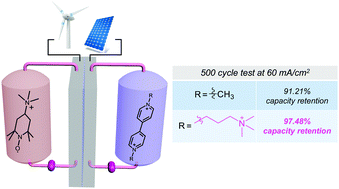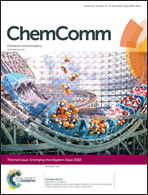Improved radical stability of viologen anolytes in aqueous organic redox flow batteries†
Abstract
A high voltage (1.38 V) total organic aqueous redox flow battery is reported using 1,1′-bis[3-(trimethylammonio)propyl]-4,4′-bipyridinium tetrachloride ((NPr)2V) as an anolyte and 4-trimethylammonium-TEMPO chloride (NMe-TEMPO) as a catholyte. The exceptional radical stability of [(NPr)2V]+˙ enabled the flow battery in achieving 97.48% capacity retention for 500 cycles and a power density of 128.2 mW cm−2.

- This article is part of the themed collection: 2018 Emerging Investigators


 Please wait while we load your content...
Please wait while we load your content...